Nashville, the vibrant capital of Tennessee, is renowned for its rich musical heritage, lively entertainment scene, and historical landmarks. At the very core of this bustling city lies its Main Street, famously known as Broadway, a thoroughfare that pulses with the rhythm of country music and the echoes of history. This iconic street is more than just a road; it’s the beating heart of Nashville, drawing visitors into a historical and cultural adventure unlike any other.
From Riverfront Docks to Music City Main Street
Broadway’s story begins in Nashville’s earliest days, when the city was a burgeoning port on the Cumberland River. The eastern end of Broad Street, as it was initially known, served as the city’s bustling wharf area. Today’s Lower Broadway was the epicenter of trade and commerce, connecting the river docks to Market Street (now Second Avenue) and the public square’s vendor stalls. In the original city plan, Broad Street was strategically positioned as one of only three east-west roadways, highlighting its importance from the outset.
During the 19th century, Nashville’s Main Street transformed into a vital commercial artery. Hardware stores, feed suppliers, and various enterprises lined Broadway, fueling the city’s growing economy. A significant milestone in Broadway’s history occurred in 1875 when it became home to Nashville’s first public high school, marking its role in the city’s educational development. As the 20th century dawned, Broadway entered the automotive age, earning the moniker “Auto Row” due to the proliferation of car dealerships, tire shops, and auto parts stores. This evolution mirrored the changing times and Broadway’s adaptability as Nashville’s central street.
The Great Depression brought further transformation. Recognizing the importance of rail transport for mail, the Work Progress Administration (WPA) constructed a new post office near Union Station. While Union Station has since been elegantly repurposed into a luxury hotel, the Old Post Office now serves as the Frist Center for the Visual Arts, demonstrating the enduring legacy of these landmark buildings along Nashville’s Main Street.
Honky Tonk Highway: The Soul of Nashville’s Main Street
The 1930s marked the beginning of Broadway’s legendary association with country music. Jimmy Rodgers, a pioneer of the genre, began performing in the honky tonks of Lower Broadway, drawing aspiring musicians and songwriters to the area. This four-block stretch of Broadway became synonymous with country music, earning the celebrated nickname “Honky Tonk Highway,” akin to the famous music streets of Bourbon Street in New Orleans and Beale Street in Memphis. The bars and venues lining this street became the launchpads for countless country music legends.
However, when the Grand Ole Opry relocated from the Ryman Auditorium in the 1970s, Nashville’s Main Street faced a period of decline. But Broadway’s musical spirit proved resilient. Approximately two decades later, the reopening of the Ryman Auditorium played a crucial role in revitalizing the area. Historic commercial buildings, including the Victorian-era Merchants Hotel, were repurposed to house country western shops, restaurants, and, of course, the honky tonks that give Broadway its unique character.
Today, these establishments resonate with live music from early afternoon into the evening. Visitors can stroll along Broadway, soak in the atmosphere, and enjoy the constant soundtrack of aspiring artists and, sometimes, impromptu performances by established stars. The Honky Tonk Highway is more than just a collection of bars; it’s a living, breathing testament to Nashville’s musical soul, right on its Main Street.
Key Attractions on Nashville’s Main Street: Broadway’s Points of Interest
Broadway is not only about music; it’s also a treasure trove of historical and architectural landmarks. Several destinations along Nashville’s Main Street are listed in the National Register of Historic Places, offering a blend of entertainment and cultural enrichment.
Union Station: A Glimpse into Grand Railway History
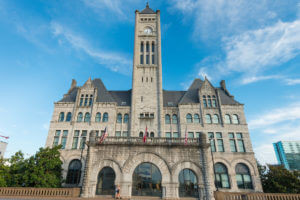 nashville union station
nashville union station
Originally built in 1900 as a majestic railroad depot, Union Station, now a luxury hotel, stands as a testament to the grandeur of Victorian-era train travel. This neo-Romanesque masterpiece features a breathtaking 65-foot-tall lobby crowned by a stained glass ceiling, intricate woodwork, and Italian marble accents. Added to the National Historic Register in 1969, Union Station offers a unique experience, blending historical significance with modern luxury right off Nashville’s Main Street.
Frist Center for the Visual Arts: Art in a Historic Post Office
Housed within the nationally historic Old Post Office, the Frist Center for the Visual Arts is a non-collecting museum that hosts an ever-changing array of traveling fine art exhibitions. It also showcases works by talented local and regional artists across various media. Constructed in 1934, this landmark building retains its preserved Art Deco interior. Visitors can even take an architectural tour on the first Saturday of each month, exploring the artistic treasures within a historical gem on Nashville’s Main Street.
Hume-Fogg High School: An Academic Castle on Broadway
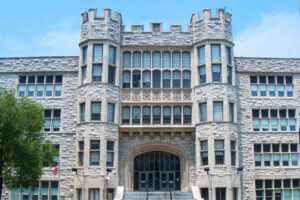 nashville hume fogg magnet high school
nashville hume fogg magnet high school
Hume-Fogg Academic Magnet High School, completed in 1912, is a striking architectural landmark resembling a medieval European castle. Its twin tower entrance makes it instantly recognizable in Music City. Designed in the Norman Gothic style by William Ittner, the stone edifice features Tudor Gothic ornamentation and cut stone figures above the entrance, representing disciplines like literature, mathematics, science, and fine arts, showcasing education’s importance on Nashville’s Main Street.
Bridgestone Arena: Entertainment Hub of Nashville’s Main Street
Bridgestone Arena, home to the NHL’s Nashville Predators, is a premier indoor venue for concerts and events. Beyond sports, it hosts the annual Country Music Association Awards and houses the Nashville Visitor Center and the Tennessee Sports Hall of Fame. Located on Broadway, it’s a central point for entertainment and visitor information in Nashville.
Tootsie’s Orchid Lounge: A Purple Icon of Honky Tonk Highway
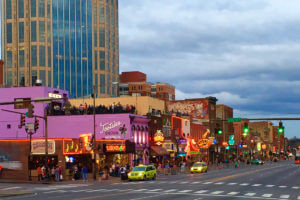 nashville tootsies orchid lounge
nashville tootsies orchid lounge
Instantly recognizable by its distinctive purple exterior (an accidental paint choice!), Tootsie’s Orchid Lounge is a world-famous honky tonk on Lower Broadway. This legendary venue has played a pivotal role in launching the careers of numerous country music stars, including Willie Nelson. Movie buffs might recognize its interior from scenes in the film Coal Miner’s Daughter, making it a must-visit spot on Nashville’s Main Street.
Ernest Tubb Record Shop: A Haven for Country Music Aficionados
Established in 1947, the Ernest Tubb Record Shop is a retail institution for country and bluegrass music lovers. Offering a vast selection of albums, memorabilia, and music from both classic and contemporary artists, it’s a treasure trove for anyone seeking to immerse themselves in the sounds of Nashville’s Main Street.
Riverfront Station: Gateway to Nashville via Rail
Riverfront Station, situated at the end of Broadway where it meets First Avenue, serves as the western terminus of the Music City Star commuter rail line. Built in 2006, its post-and-beam architecture is designed as a replica of a turn-of-the-century Tennessee Central Railroad depot, connecting Nashville’s Main Street to the wider region.
Riverfront Park: Recreation and Events at the Foot of Broadway
 nashville-riverfront-park
nashville-riverfront-park
Located at the eastern end of Broadway, Riverfront Park provides a green oasis with a playground, lawn space, and the Ascend Amphitheater. It features an ornamental garden, a greenway trail, and a dog park. This recreational area hosts numerous cultural events and celebrations, including the annual Independence Day concert and fireworks, offering leisure and entertainment at the edge of Nashville’s Main Street.
Planning Your Visit to Nashville’s Main Street
Broadway welcomes visitors throughout the year, but the peak tourist season runs from April to October. Nashville’s summers can be hot and humid, while winters approach freezing. Spring and fall offer pleasant daytime temperatures and cooler evenings, ideal for exploring on foot. Dressing in layers is recommended, especially during these shoulder seasons.
Many honky tonks on Lower Broadway are family-friendly during the day, with age restrictions typically enforced later in the evening. This allows families with children to experience the Honky Tonk Highway’s atmosphere together. Broadway is busiest on weekends and evenings, so plan accordingly if you prefer a less crowded experience.
Exploring Beyond Broadway: Nearby Nashville Attractions
Nashville’s attractions extend beyond its Main Street. Just a short distance from Broadway, you can discover even more of Music City’s cultural gems.
Ryman Auditorium: The Mother Church of Country Music
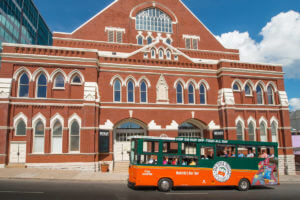 ryman-nashville
ryman-nashville
Known as the “Mother Church of Country Music,” the Ryman Auditorium is an iconic venue that hosted the Grand Ole Opry for three decades. Originally a gospel tabernacle from 1892, it now hosts headline acts and offers backstage tours. Added to the National Register of Historic Places in 1971, the Ryman is a cornerstone of Nashville’s musical heritage, a short walk from Nashville’s Main Street.
Johnny Cash Museum: Celebrating the Man in Black
The Johnny Cash Museum, located on Third Avenue South, celebrates the life and legendary career of “The Man in Black.” Interactive exhibits showcase an extensive collection of artifacts and memorabilia related to Johnny Cash, including personal items, instruments, and stage costumes, offering a deep dive into the legacy of this music icon near Nashville’s Main Street.
Goo Goo Shop: Indulge in Nashville’s Sweet Treat
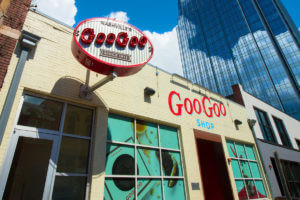 nashville goo goo shop
nashville goo goo shop
Just steps from Broadway, the Goo Goo Shop is a confectionery haven offering vintage candies and its signature Goo Goo Cluster, a Southern delight of milk chocolate, marshmallow, caramel, and peanuts. Visitors can watch these treats being made by hand, providing a sweet taste of Nashville near the city’s Main Street.
Nashville’s Main Street, Broadway, is a vibrant tapestry of history, music, and entertainment. From its riverfront origins to its status as the Honky Tonk Highway, Broadway encapsulates the spirit of Music City. Exploring this iconic street and its surrounding attractions offers an unforgettable journey into the heart of Nashville’s unique culture.

